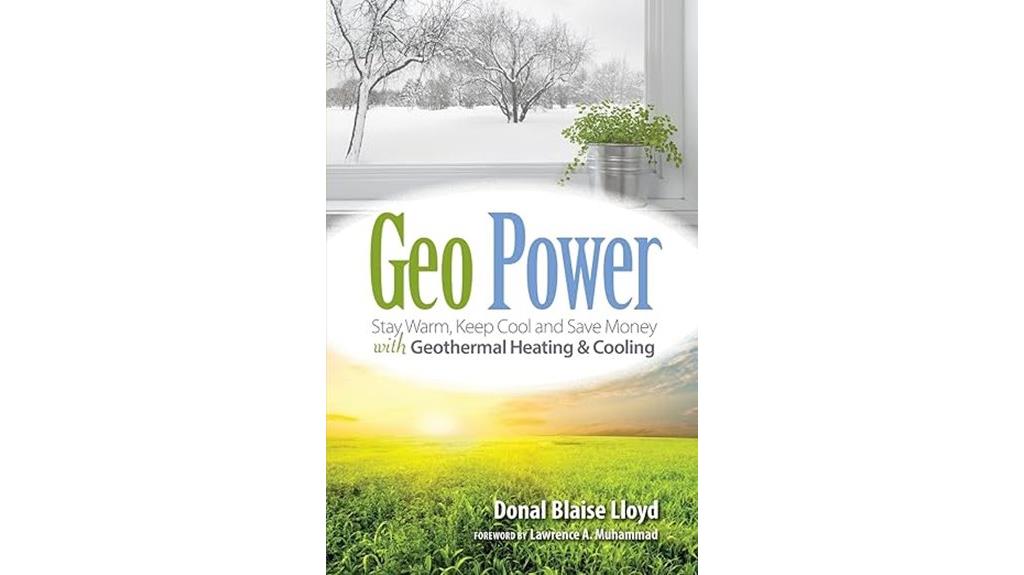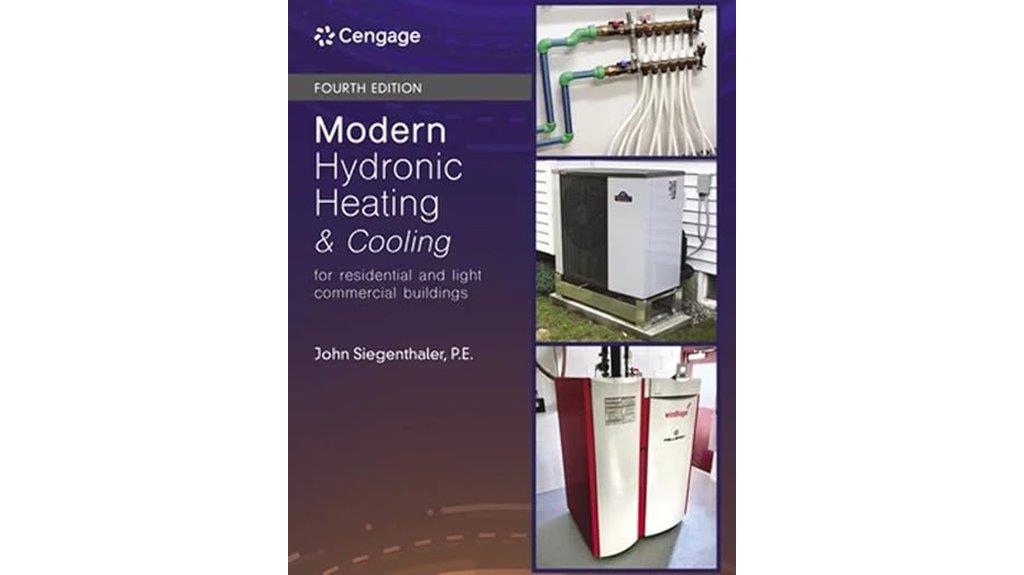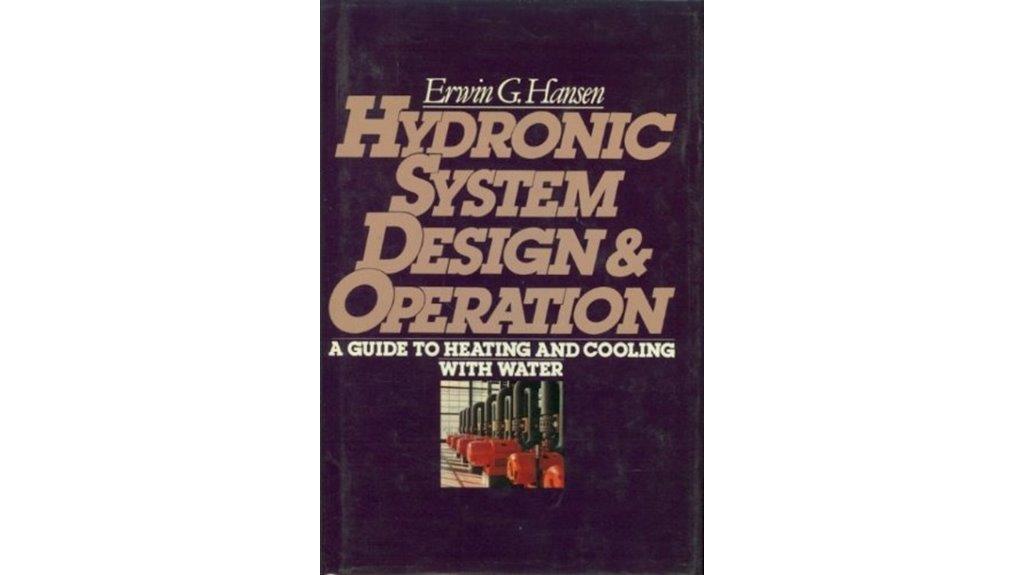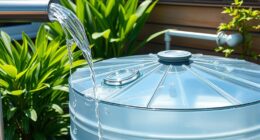If you want to deepen your understanding of geothermal heat pumps in 2025, I recommend exploring the top nine books listed, including titles like *Geo Power*, *Heat Pumps*, and *Geothermal Heat Pumps*. These books cover everything from beginner basics to advanced system design and troubleshooting. With detailed diagrams, practical insights, and expert guidance, they’re perfect for professionals or homeowners. Keep going, and you’ll discover even more useful tips and technical details to boost your expertise.
Key Takeaways
- The list includes beginner-friendly titles like *Geo Power* and advanced technical resources such as *Heat Pumps* series.
- Visual aids like diagrams and schematics are emphasized to enhance understanding across all titles.
- Resources vary from practical installation guides to in-depth system design and troubleshooting manuals.
- Selection depends on technical depth, climate relevance, visual quality, author expertise, and application focus.
- The list helps readers find comprehensive, reliable books to deepen geothermal heat pump knowledge in 2025.
Geo Power: Geothermal Heating & Cooling System

If you’re a homeowner or building owner curious about making your space more energy-efficient, “Geo Power: Geothermal Heating & Cooling System” is the perfect starting point. This clear, accessible book explains geothermal heating and cooling technologies with detailed diagrams and practical insights. I appreciate how it breaks down complex concepts like geothermal loops and heat pump functions, making them easy to understand. It highlights the environmental benefits, like reducing energy costs and lowering carbon emissions, especially for colder climates. Whether you’re a beginner or looking to deepen your knowledge, this book provides a solid foundation to explore geothermal options confidently.
Best For: homeowners and building owners new to geothermal heating and cooling seeking a clear, practical introduction to the technology.
Pros:
- Easy-to-understand explanations with detailed diagrams that clarify complex concepts.
- Emphasizes environmental benefits like reducing energy costs and carbon emissions.
- Suitable for beginners and those looking to build confidence in exploring geothermal options.
Cons:
- Primarily focused on colder climates, with limited guidance for hot or temperate regions.
- Less detailed technical information compared to professional manuals or industry guides.
- Some regional considerations, such as fuel costs, may not be directly applicable outside colder climates.
Heat Pumps: Operation, Installation, Service

For field technicians and HVAC professionals seeking a practical, easy-to-understand reference on heat pump operation, installation, and service, this book stands out as an essential resource. It’s well-structured, with detailed explanations, wiring schemes, and colored illustrations that make complex systems accessible. Many users praise its usefulness for troubleshooting and fieldwork, often referencing quick guidance during installations or repairs. While some find it limited in scope, most agree it offers valuable, practical insights for daily use. If you need a reliable, straightforward guide to help you understand heat pump systems better, this book is a highly recommended tool.
Best For: HVAC field technicians and professionals seeking a practical, easy-to-understand reference for heat pump operation, installation, and troubleshooting.
Pros:
- Well-structured with detailed explanations and wiring diagrams, making complex systems accessible.
- Highly praised for practical guidance and quick reference during fieldwork.
- Color illustrations and clear layout enhance understanding and usability.
Cons:
- Limited content in the Kindle version compared to the print, reducing educational value.
- Some reviewers find the material superficial and lacking in-depth technical detail.
- The book’s scope may be too basic for advanced or academic learning needs.
Heat Pumps

Anyone looking to master heat pump technology will find “Geothermal Heat Pump Books” an invaluable resource. Heat pumps transfer heat between indoor and outdoor environments, offering efficient heating and cooling solutions. They work even in cold weather by extracting heat from outside sources and moving it indoors. Many books cover system design, troubleshooting, and operation, often including detailed diagrams and practical insights. These resources are praised for clarity and thoroughness, making them ideal for students and professionals. Understanding the technical details and performance factors, like climate influence and system efficiency, is essential for effective application and ongoing system optimization.
Best For: students, professionals, and HVAC technicians seeking comprehensive, clear, and practical resources on heat pump technology and system design.
Pros:
- Offers detailed explanations with schematic and ladder diagrams for easier understanding
- Well-reviewed for clarity, thoroughness, and practical insights into operation and troubleshooting
- Covers critical factors like performance, climate influence, and efficiency to optimize system use
Cons:
- Some resources may be technical and require prior basic knowledge of HVAC systems
- Books can be costly or lengthy, requiring dedicated time for study
- May need supplementary practical experience for complete mastery of hands-on troubleshooting
Geothermal Heat Pumps: A Guide for Planning and Installing

Geothermal Heat Pump Books is best suited for those with some technical background or hands-on experience who want a practical overview of planning and installing geothermal systems. I’ve personally found it valuable for its real-world insights gained from over eight years of installing Water Furnace heat pumps. The book covers energy calculations, system types, and practical applications like using thermal collectors in barns. While it doesn’t provide detailed engineering formulas, it offers useful equations and a straightforward style that helps facilitate discussions with professionals. However, its high cost and limited depth make it less ideal for those seeking all-encompassing design guidance.
Best For: individuals with some technical background or hands-on experience seeking a practical overview of planning and installing geothermal heat pump systems.
Pros:
- Provides real-world insights from extensive hands-on experience.
- Includes useful equations and straightforward explanations to facilitate professional discussions.
- Covers a variety of system types and practical applications like thermal collectors.
Cons:
- Lacks detailed engineering formulas and comprehensive design guidance.
- High cost ($95) and reliance on metric units reduce practicality for U.S. users.
- The content is somewhat limited and may be redundant due to readily available free online resources.
Heat Pumps: Heating, Cooling & Installation Guide

If you’re looking to master the fundamentals of heat pump technology, this guide offers clear, step-by-step instructions perfect for beginners and professionals alike. I walk you through how heat pumps function for heating and cooling, including essential principles, benefits, and real-world applications. The book emphasizes careful planning, like site assessment and system sizing, so your setup is efficient and tailored to your needs. Installation details cover mounting, refrigerant connections, and wiring, while commissioning ensures top performance and safety. With troubleshooting tips, checklists, and resources, this guide equips you to confidently install, maintain, and optimize your heat pump system.
Best For: beginners and professionals looking to understand, install, and maintain heat pump systems for efficient heating and cooling.
Pros:
- Comprehensive step-by-step guidance suitable for both novices and experienced technicians
- Covers planning, installation, commissioning, and troubleshooting for complete system management
- Includes practical tools like checklists and additional resources to ensure safety and performance
Cons:
- Technical content may be challenging for complete beginners without prior HVAC knowledge
- Some detailed procedures may require specialized tools or skills beyond basic DIY capabilities
- The guide assumes a certain level of familiarity with electrical and refrigeration systems, which might necessitate further training
Modern Hydronic Heating and Cooling Book

Modern Hydronic Heating and Cooling: For Residential and Light Commercial Buildings stands out as the ideal resource for professionals and DIY enthusiasts seeking a thorough understanding of hydronic systems that incorporate advanced heat pump technologies. Authored by industry expert John Siegenthaler, it covers system design, installation, troubleshooting, and energy-saving methods, emphasizing meticulous planning for efficiency and longevity. The book offers clear explanations, detailed schematics, and practical guidance on integrating high-COP heat pumps and hot water storage. Its balanced approach makes complex concepts accessible, whether you’re a novice or experienced tradesperson. Despite its price, the all-encompassing content makes it an invaluable reference for mastering modern hydronic heating and cooling systems.
Best For: professionals and DIY enthusiasts seeking a comprehensive, detailed guide on modern hydronic heating and cooling systems incorporating advanced heat pump technologies.
Pros:
- In-depth coverage of system design, installation, and troubleshooting.
- Clear explanations, detailed schematics, and practical guidance suitable for all skill levels.
- Focus on energy efficiency and integration of high-COP heat pumps and hot water storage.
Cons:
- High price may be a barrier for some users.
- Primarily uses Imperial units, which may be less convenient internationally.
- The extensive technical detail might be overwhelming for complete beginners without prior experience.
HVACR 401: Heat Pumps

Looking to deepen your understanding of heat pumps, especially geothermal systems? HVACR 401 is a focused manual designed for technicians, providing clear, practical insights into heat pump operation, troubleshooting, and maintenance. It uses straightforward language and diagrams to simplify complex concepts, making it accessible on the field. The book emphasizes effective communication with homeowners and offers tips drawn from real-world stories. Its durable, well-organized layout makes it a valuable reference during service calls. If you want to master geothermal heat pumps and improve your technical skills, this manual is an essential resource that boosts confidence and efficiency in the field.
Best For: HVAC technicians seeking a practical, easy-to-understand manual to master heat pump systems, including geothermal technology, for effective troubleshooting and customer communication.
Pros:
- Clear, straightforward language and diagrams that simplify complex concepts.
- Durable laminated pages suitable for field use and quick reference.
- Focus on real-world communication tips and troubleshooting strategies.
Cons:
- May require prior basic HVAC knowledge for full comprehension.
- Primarily targeted at technicians; less useful for laypersons or homeowners.
- Focused on heat pumps; not applicable to other HVAC system types.
GeoCool 4 Ton Geothermal Heat Pump Vertical Package Unit

The GeoCool 4 Ton Geothermal Heat Pump Vertical Package Unit stands out as an ideal choice for professionals and homeowners seeking an energy-efficient heating and cooling solution. Its model GCSHPD048IGN offers a 71 EER rating, ensuring excellent efficiency. Designed for vertical upflow installation with bottom return, it’s compact at just under 75 inches tall and weighs 51 pounds. Using environmentally friendly R-410A refrigerant, it’s built for durability, backed by a 10-year parts and 5-year labor warranty. Installation requires a licensed professional, and the unit is suitable for those prioritizing sustainable, cost-effective HVAC systems. It became available in April 2024, highlighting its modern design.
Best For: homeowners and HVAC professionals seeking an energy-efficient, durable geothermal heat pump for vertical upflow installation.
Pros:
- High efficiency with a 71 EER rating, reducing energy costs
- Compact vertical design suitable for limited space installations
- Environmentally friendly R-410A refrigerant and extensive warranty coverage
Cons:
- Installation requires a licensed professional, adding to initial setup costs
- Relatively lightweight at 51 pounds, which may require careful handling during installation
- Limited to vertical upflow configuration with bottom return, reducing versatility in some setups
Hydronic System Design and Operation Guide

If you’re a consulting engineer or system designer seeking a detailed, technical resource on hydronic systems, “Hydronic System Design and Operation: A Guide to Heating and Cooling With Water” is an indispensable choice. This exhaustive book covers water-based heating and cooling systems across a wide temperature range, with in-depth guidance on design principles, system selection, and operational considerations. It emphasizes creating efficient, reliable systems that perform under all load conditions. Its detailed illustrations enhance understanding of complex concepts, making it invaluable for designing chilled water, hot water, and high-temperature hot water systems. Despite its age, it remains a highly recommended, authoritative resource for industry professionals.
Best For: consulting engineers and system designers seeking an in-depth, technical guide to hydronic heating and cooling system design and operation.
Pros:
- Comprehensive coverage of water-based heating and cooling systems across a broad temperature range
- Highly detailed illustrations that clarify complex concepts and aid understanding
- Focus on practical, energy-efficient, and reliable system design principles
Cons:
- Highly technical content that may be challenging for beginners or those new to hydronics
- Outdated publication date with no recent updates or revisions available
- Large volume of detailed information can be overwhelming without prior experience
Factors to Consider When Choosing Geothermal Heat Pump Books

When selecting geothermal heat pump books, I consider how much technical detail I need and whether the content matches my climate zone. I also look for clear visuals and practical advice that I can apply directly. Additionally, I pay attention to the author’s expertise to make sure I’m getting reliable, in-depth information.
Technical Depth Needed
Determining the appropriate technical depth for geothermal heat pump books depends on your current knowledge and goals. If you’re new to the field, start with introductory materials that cover basic concepts and system operation. For those aiming to design, install, or troubleshoot systems professionally, look for books with detailed coverage of system design, installation procedures, troubleshooting techniques, and performance analysis. Make sure the material includes clear diagrams, schematics, and real-world examples to improve understanding. Be aware that highly technical books often feature complex formulas, engineering calculations, and industry standards necessary for detailed planning. Balancing the book’s technical depth with your objectives guarantees you gain relevant knowledge without feeling overwhelmed, whether you’re just learning or seeking advanced expertise.
Climate Relevance
Considering climate is essential when selecting geothermal heat pump books because regional temperature variations considerably influence system design and performance. Books focused on colder climates highlight ground temperature stability, frost depth, and seasonal efficiency, which may not be relevant in warmer regions. For hotter or temperate areas, it’s important to find resources that address soil thermal properties, seasonal load differences, and alternative systems like air-source or hybrid setups. The effectiveness and sizing of geothermal systems discussed in these books depend heavily on local ground conditions and temperature ranges, which vary widely. Choosing a book tailored to your climate ensures you get accurate guidance for optimizing performance and efficiency. Avoiding climate-specific mismatch helps you better adapt geothermal solutions to your regional needs.
Visual Aids Quality
High-quality geothermal heat pump books stand out because they include detailed, clear diagrams and illustrations that make complex system components easier to understand. Visual aids like schematics, flowcharts, and exploded diagrams help break down installation and troubleshooting steps, making technical processes accessible. Well-designed images with accurate labels enable me to distinguish between different geothermal system types, piping layouts, and heat pump configurations. The use of color-coded diagrams further clarifies refrigerant cycles and heat transfer mechanisms, reducing confusion. Professionally rendered visuals and consistent formatting enhance my ability to retain technical concepts and apply them practically. When choosing a book, I look for high-quality visual aids that support learning, ensuring I grasp intricate details without unnecessary complexity.
Practical Guidance Offered
When selecting a geothermal heat pump book, I focus on the practical guidance it provides to guarantee I can implement and troubleshoot systems effectively. I look for resources with clear troubleshooting tips, system design advice, and installation procedures that help me navigate real-world challenges. Detailed diagrams and schematics are essential, as they clarify complex refrigeration cycles and system components, making diagnosis easier. I also value case studies and energy calculations that offer insights into optimizing performance. Regional considerations, like climate-specific tips and code compliance, are vital for tailored system planning. Additionally, checklists, step-by-step instructions, and troubleshooting flowcharts boost usability, giving both DIY enthusiasts and professionals practical tools to ensure efficient, compliant, and reliable geothermal system installation and maintenance.
Author Expertise Level
Choosing a geothermal heat pump book with credible authors guarantees I get reliable, in-depth information. To assess an author’s expertise, I look at their professional background, practical experience, and industry recognition. Authors with advanced technical credentials, such as engineering degrees or certifications from organizations like IGSHPA, tend to provide accurate, comprehensive insights. Personal field experience, like years installing or designing geothermal systems, further boosts credibility and depth. I also consider whether they’re affiliated with reputable organizations, which signals commitment and expertise. Reading reviews and endorsements from industry professionals helps me ensure their knowledge aligns with my learning or project needs. Ultimately, selecting books authored by recognized experts ensures I gain trustworthy, valuable knowledge to support my geothermal endeavors.
Frequently Asked Questions
What Are the Latest Innovations in Geothermal Heat Pump Technology for 2025?
You’re curious about the latest innovations in geothermal heat pump technology for 2025. I’ve been following recent developments, and I can tell you that advanced borehole drilling techniques, enhanced heat exchanger materials, and smart control systems are leading the way. These innovations improve efficiency, reduce installation costs, and allow for smarter energy management. It’s exciting to see how these advancements make geothermal systems more accessible and sustainable for both residential and commercial use.
How Do Geothermal Heat Pumps Compare to Traditional HVAC Systems Efficiency-Wise?
Did you know geothermal heat pumps are often more efficient than traditional HVAC systems? I’ve found that they use the stable underground temperature to heat and cool more effectively, reducing energy consumption. Unlike conventional systems that rely on outside air, geothermal systems can achieve efficiency levels of 300-500%. That means lower bills and a smaller carbon footprint. I highly recommend exploring these systems if you’re aiming for sustainable, cost-effective climate control.
Are There Beginner-Friendly Books on Geothermal Heat Pump Installation Techniques?
You’re asking if beginner-friendly books on geothermal heat pump installation techniques exist. I’ve found several that are perfect for newcomers, offering clear step-by-step guides and simple explanations. These books break down complex concepts into easy-to-understand language, making it easier for beginners to grasp the basics and start their projects confidently. If you’re just starting out, I highly recommend these resources—they’re practical and accessible.
What Are the Environmental Benefits of Using Geothermal Heat Pumps?
Think of geothermal heat pumps as nature’s own air conditioners, cooling and heating with the Earth’s gentle embrace. I’ve found they greatly reduce greenhouse gas emissions because they rely on renewable underground energy, cutting down fossil fuel use. Plus, they improve air quality and lower energy consumption, helping us combat climate change. Switching to geothermal isn’t just smart; it’s a crucial step toward a healthier planet I’d love to see everyone take.
How Can I Find Certified Geothermal Heat Pump Professionals in My Area?
To find certified geothermal heat pump professionals near you, I recommend starting with the geothermal heat pump industry’s certification programs like the North American Technician Excellence (NATE) or the Geothermal Heat Pump Consortium (GHPC). You can also check online directories, local HVAC companies, or ask for referrals from neighbors who’ve installed geothermal systems. Always verify their certifications and experience to make certain you’re working with qualified experts.
Conclusion
Diving into these books will give you a solid grasp of geothermal heat pumps, but remember, knowledge is only part of the journey. As the saying goes, “A little knowledge is a dangerous thing,” so keep learning and stay curious. Whether you’re installing or designing systems, these resources will guide you step by step. With patience and persistence, you’ll master the art of geothermal heating and cooling in no time.






